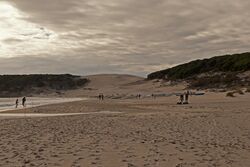بولونيا، إسبانيا
Bolonia | |
|---|---|
Village and beach | |
 | |
| الإحداثيات: 36°4′17″N 5°41′40″W / 36.07139°N 5.69444°W | |
| Country | |
| Autonomous community | |
| Province | Cádiz |
| Comarca | Campo de Gibraltar |
| Municipality | Tarifa |
| Judicial district | Algeciras |
| التعداد (2011) | |
| • الإجمالي | 117 |
| منطقة التوقيت | UTC+1 (CET) |
| • الصيف (التوقيت الصيفي) | UTC+2 (CEST) |
| Official language(s) | Spanish |
Bolonia is a coastal village and beach in the municipality of Tarifa in the Province of Cadiz in southern Spain. It is located on the Atlantic shore, 22.9 kilometres (14.2 mi) by road west of Tarifa, but is much closer in terms of coastal distance. The beach and bay is also known as Playa de Bolonia ("Bolonia Beach"), Ensenada de Bolonia ("Bolonia Cove"), or Bolonia Bay. The ruins of the Roman town of Baelo Claudia are located near the beach, considered to be the most complete Roman town ruins yet uncovered in Spain.[1][2] The beach is about 3.8 kilometres (2.4 mi) in length, with an average width of about 70 metres (230 ft). In 2011 it had a population of 117 people.
. . . . . . . . . . . . . . . . . . . . . . . . . . . . . . . . . . . . . . . . . . . . . . . . . . . . . . . . . . . . . . . . . . . . . . . . . . . . . . . . . . . . . . . . . . . . . . . . . . . . . . . . . . . . . . . . . . . . . . . . . . . . . . . . . . . . . . . . . . . . . . . . . . . . . . . . . . . . . . . . . . . . . . . .
الوصف
It is limited to the west by Punta Camarinal and to the east by Punta Paloma ; in the interior it is bordered by the Sierra de La Plata , the Sierra de la Higuera and the San Bartolomé hill. 2
It has a length of 3800 meters and an average width of 70 meters. It is one of the few virgin beaches with tuna that can be found in the south of the Iberian Peninsula . 1 The scarce human occupation of the surrounding area has led to its conservation, since there is only a small population center. 3
At its eastern end there are some natural pools that can only be reached on foot 4
المدينة الرومانية
 مقالة مفصلة: بايلو كلوديا
مقالة مفصلة: بايلو كلوديا
Next to the beach are the ruins of the ancient Roman city of Baelo Claudia , in an excellent state of conservation. The city was created from a Phoenician settlement, already at the end of the 2nd century BC, and a year later, the city reached its maximum splendor. It was of great importance as a seaport, being the link with Africa, although it was the almadraba that provided the city with its main economic activity. In 1917 it was discovered by a French archaeologist, and in 2013 four students from the University of Cádiz discovered the formula for making garum, which was the driving force behind tuna fishing, since it was exported from here to the entire Roman Empire; that is, they were pioneers in the production and marketing of canned fish. Currently, a visitor center and a museum have been built, which can be visited next to the site every day (except Mondays), free of charge. 5 It is believed that it is this Roman city that gives the beach its name. From Baelo to Baelonia to today Bologna.
كثبان بولونيا
 مقالة مفصلة: كثبان بولونيا
مقالة مفصلة: كثبان بولونيا
In the western sector of the beach is the Bolonia dune , a natural monument declared in 2001 and of great ecological importance. 6 The Bolonia dune system is tremendously mobile and naturally prevents the establishment of plant species except the marram grass , a species adapted to burial that helps maintain the dune. The innermost parts of the dunes are populated by stone pine , from reforestation, with an understory of juniper , mastic and maritime juniper. The continuous advance of the sand causes death by burying the pines; however, this advance is natural and the current conservation measures recommend that it not be prevented.
المراجع
- ^ Sintubin, M. (1 October 2010). Ancient Earthquakes. Geological Society of America. p. 131. ISBN 978-0-8137-2471-3. Retrieved 19 February 2013.
- ^ Lonely Planet (2011). Andalucí – Guidebook Chapter. Lonely Planet. p. 88. ISBN 978-1-74321-252-3. Retrieved 19 February 2013.






